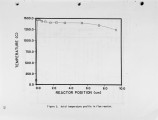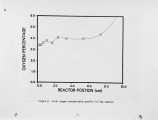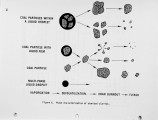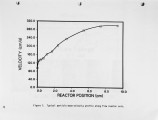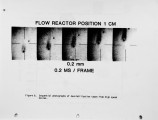| OCR Text |
Show Prior to performing comparisons of the various CWS mixtures, the effect of air atomization was determined for three different flowrates, shown in Figure 10 for slurry #1. As expected, the lowest air flowrate gave the poorest atomization, producing a higher number density of the largest particles combined with a low number density of the smaller particles. Higher air flowrates produce dramatically larger numbers of particles in the 1-5 micron size range, but have a small influence on the largest particles formed. These large numbers of fine particles, although small by mass will be important in determining the slurry ignition characteristics. A flowrate of 8 liters per minute was chosen as a standard condition for comparison measurements, since this gave good atomization along with reliable slurry feed properties, and best matched our flow reactor velocity conditions. Reproducibility of measurements for a given slurry flowrate within a given run, and at different times has been checked as shown in Figure 11 for slurry #4. Measurements within a given slurry run (less than five minutes) show very close agreement (indicated by the date in the filename, e.g. J20). Measurements on J27, a week later also show good internal consistency, but differ somewhat due to a variation in the atomization characteristics of the flowreactor. Other measurements have been compared at periods of greater than two months with consistent results. We conclude that variations in atomizer feed conditions are acceptable but account for the largest uncertainty in comparison of the distribution measurements. Atomization, Agglomeration, Swelling, and Burnout Figure 12 shows the results for a fine grind slurry (#3) with the original ash content retained. The interaction of the atomizer and fuel properties are particularly important in determining the optimal fuel processing requirements. An immediate observation for the cold flow distribution is the significant number of particles above 20 microns, (the maximum size of the raw pulverized coal), with a top size of 70 microns. This result is confirmed by microscope observations of atomized slurry collected on glass slides which show spherical agglomerates of the original pulverized coal solids. Furthermore, the size of the largest agglomerates observed in the microscope sample correspond to the largest particles measured by the PCSV instrument. Thus, the atomization process is generating agglomerated slurry particles larger than the pulverized coal for this slurry. Also generated are large numbers of small particles, approximately three orders of magnitude more than the number density of the largest slurry particles. Referring back to Figure 9, (slurry #1, which has a pulverized coal top size of 80 microns) we find that the largest particles formed under cold flow atomization conditions are also about 80 microns. Comparison of the results for the top particle size in Figures 9 and 12 indicate that atomization, not particle grind, is controlling the largest particles or agglomerates formed. Other observations from Figure 9 show that below about 80 microns the number density decreases uniformly with increased residence time, which could be due to particle burnout or transverse particle diffusion. In contrast to this general decrease, at about 5 ms residence time, a small increase in the number density of particles above 80 microns occurs, indicating particle swelling. An overall picture of number density effects |

























